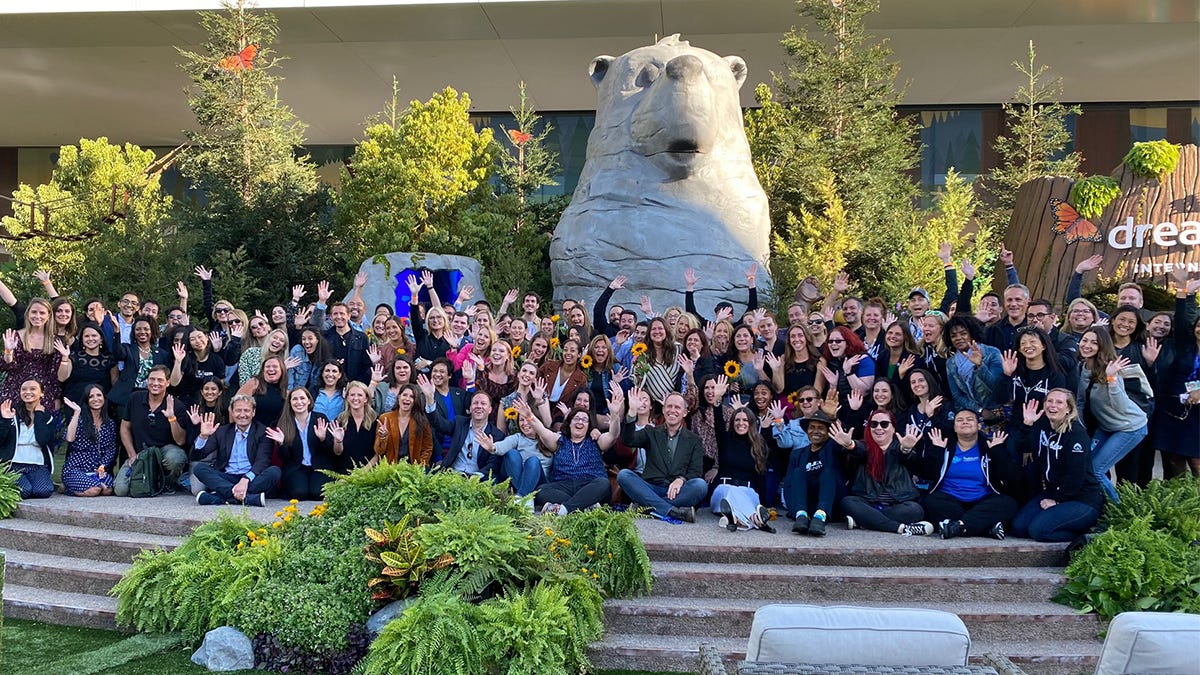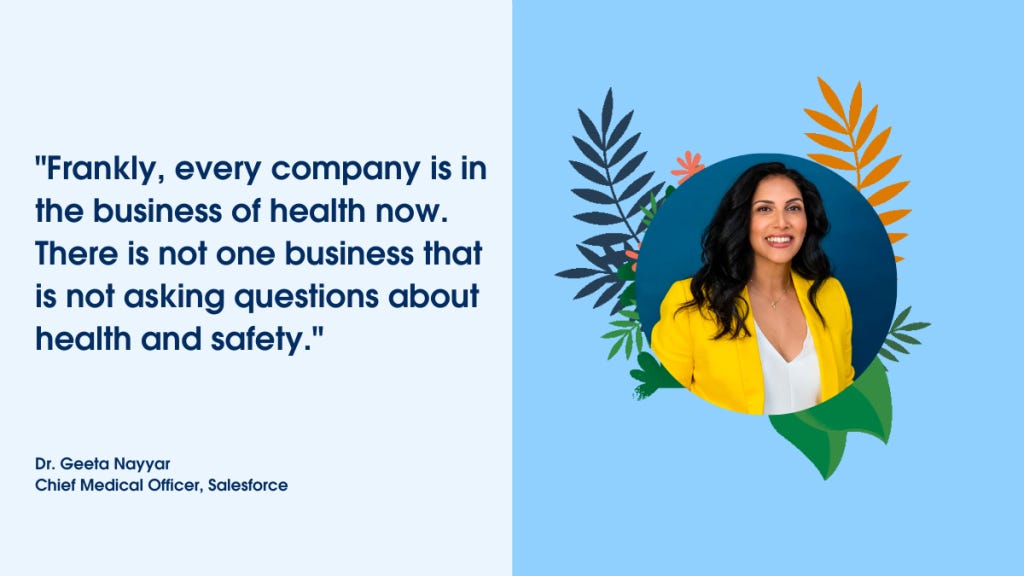Every company is in the business of health
As the COVID-19 pandemic evolves, companies need to develop a strategy and execution plan for hosting in-person events. Data shows that getting people together safely and in-person is imperative to building and maintaining culture, employee retention and satisfaction, and business growth.
According to the American Express Meetings & Events Global Forecast, 81% of meeting and event professionals expect their events in 2022 to have an in-person element. A Harvard Business Review survey shows that, while hybrid work may be here to stay, there is an emerging consensus among business owners and employees that they are looking to be back in the office three days per week, on average.
Also: Global research: 3 out of 4 professionals do not feel ready to work in a digital-first world
To ensure the safety of stakeholders, Salesforce created the Event Health and Safety Playbook.
The playbook includes sections on:
- Assembling the right team of experts
- Leading with COVID-19 vaccines and testing
- Embracing on-site protocols and practices
- Creating an easy, tech-enabled experience
- Investing in preparation along with transparent, proactive communication

The Event Health and Safety Playbook enabled Salesforce to host Dreamforce San Francisco with 1,000+ in-person attendees.
“When the pandemic changed everything overnight, many of our customers came to us and said, “We need digital transformation. We have to start seeing patients from the living room! How can you help us?” That’s part of the inspiration behind publishing the playbook and making it a free resource for other organizations. We want to share what we learned so more, and more people can start getting together again more safely,” said Dr. Nayyar, chief medical officer at Salesforce.
According to Dr. Nayyar, every company is in the business of health now — there is not one business that is not asking questions about health and safety.

Every business is in the business of health now.
The biggest lesson that Dr. Nayyar learned in terms of bringing people back together more safely at live events was the importance of the partnership with the chief marketing officer.
“We learned a lot from Dreamforce and wrote about some key takeaways in the playbook, but number one is the importance of teamwork. We brought together a team of experts from across and beyond the company. From ‘CMO squared’ — the partnership of the Chief Marketing Officer and the Chief Medical Officer, to a team of epidemiologists and statisticians — each of us had the expertise, a ‘lane,’ that was very important to creating a successful Dreamforce,” said Dr. Nayyar.
The ‘CMO squared’ teamwork — chief marketing officer and chief medical officer — has led to a strong partnership between Sarah Franklin, Salesforce’s chief marketing officer and Dr. Nayyar, Salesforce’s chief medical officer. Franklin and Nayyar have hosted roundtables with other CMOs in order to develop a health and safety playbook further and support technology solutions and services.
Here are some of the lessons learned based on CMO-squared collaborations (Franklin and Dr. Nayyar) with customer-partner discussions:
- Lead with Science: Business, Medicine and Technology are now key to digital transformation across all sectors, and that partnership is clearly demonstrated by the CMO squared on your company leadership teams. Companies need to lead with science on their side and develop short and long-term points of view. Having medical advice and science-backed advice is key – we have to be led by science and medicine in every critical strategic business decision. That’s why the collaboration between Chief Marketing Officer & Chief Medical Officer is critical in the pandemic world, i.e. “CMO squared”. Business, medicine and technology coming together to inform product, strategy & risk assessment requires strong communication and collaboration strategy, informed by science, led by both CMOs.
- CMO Squared: The COVID-19 pandemic has shown us that leading with trust and science is more important than ever. People are thirsty for leadership and trust, bringing people together in the pandemic, earning the trust of customers/brands. The burden of strong communication and establishing meaningful engagements that can lead to trust cannot and should not fall on the Chief Marketing Officer alone — there needs to be a medical officer involved.
- Humility is key: CMOs must use transparency as a big part of marketing and communications – the intention is to lead and get together safely. By being open and transparent from the beginning, companies can build trust with customers and employees. By acknowledging best information/science at a particular moment of time, with a combined CMO squared leadership point of view, can effectively demonstrate well intentions and garner trust.
- The COVID19-pandemic world is a team sport: Many members of the C-suite need to support the CMOs. The Chief Medical Officer may call on human Resources, Product and R&D Teams, and other scientific advisors. Executives must work together at different points of the COVID-19 pandemic to make strategic decisions. First, have a strategy eyes open on risk and risk mitigation and collectively find that intersection between science, business strategy and execution.

Sarah Franklin, chief marketing officer at Salesforce, is collaborating with other CMOs and chief medical officers in order to further develop Event Health and Safety Playbook, Safety Cloud and future innovative solutions to protect all stakeholder.
5. Chief Marketing officers can help define the want and goals while working with the medical officer to ensure that it can happen safely.
- Risk Assessment: Companies are leaning into data to make decisions when coming together. Companies must ask themselves: what is the burden on the health system or the medical field if we bring large groups of people together? A COVID-19 command center is key to understanding the risk.
- Reputation and Optics Risks: Managing the reputational risks of convening employees and customers during a global pandemic is a tricky area to navigate. By leading with humility and transparency, you can mitigate concerns and criticism. Thought leadership provided by a Chief Medical Officer and insights into the science “behind the scenes” and thought process on risk mitigation can also provide reputational cover. Having science-backed protocols in place can help assure that you are delivering a program that every executive and employee is confident in — having a medical voice that is there to assure and be transparent about the safety of protocols and demonstrates the application of science as best up to date with pandemic for the moment in time in question.
6. Companies are leaning into hybrid and metaverse: The COVID-19 pandemic forever changed the way we operate. Many Chief Marketing Officers expressed that leaning into a hybrid and safe workplace is the way of the future. CMOs adopted a mindset of only bringing employees together when a business needs to do so. Agility being key to the ability to flex at different moments during the pandemic and also allowing employees/customers to self-select based on their own medical risk profile allows an inclusive environment.
Also: Employee satisfaction increases as a result of automation in the workplace
7. Mental Health: There isn’t enough conversation around the mental health impacts that people are feeling from being isolated and working alone for almost two years. There is churn and burn, especially across marketing organizations that have had to reinvent every event experience for over two years. This is a major downstream effect on adults and families during the pandemic must be acknowledged and supported by employers. There must be a balance between both mental and physical health, some areas that have worked for companies: Examples shared during roundtables hosted by Franklin and Dr. Nayyar were: Coffee chats, B-Well Mental health series, hours of fun, doubling down on recognition programs (all areas of possible CMO squared partnership to help drive and inform the content that is employee-facing but acknowledges struggles with the current pandemic environment).
8. Budget and ROI: In the new pandemic world, bringing people together safely comes at a cost. From extra tests, technology and safety protocols, CMOs need to budget more than ever before. How does a CMO articulate the “COVID tax” and ensure ROI when bringing everyone together? These are important outstanding issues that all chief marketing officers are challenged within the new pandemic era.
The result of ‘CMO-squared’ collaborations like this has led to the creation of a new platform, called Safety Cloud, to help companies safely host in-person events by monitoring and managing COVID-19 safety measures based on the events health and safety playbook. Safety Cloud supports integrations with at-home, pharmacy and on-site testing options, including CVS Health®, eMed, Cue Health, ixlayer, and Senneca DX. These supported testing options can be connected directly to Safety Cloud, making the testing experience easier than ever. In addition, Safety Cloud will support SMART Health Cards and EU Digital COVID Certificates, which are paper or digital versions of clinical information, such as vaccination history or test results.
Every company is in the health business. The health and safety of stakeholders — employees, customers, business partners and communities — is now a brand pillar. In order for companies to safely return to in-person events, business leaders must develop a strong and trustworthy playbook supported by information technology and solutions to ensure the health and safety of all. The importance of marketing, and chief marketing officers, to lead with science with the objective to earn trusted and healthy engagements mean stronger collaboration with medical experts and resident chief medical officers to ensure business continuity and the health and safety of all stakeholders.





Pingback: http://www.airlinetickets.de/gourl.php3?url=https://phforums.co.za/